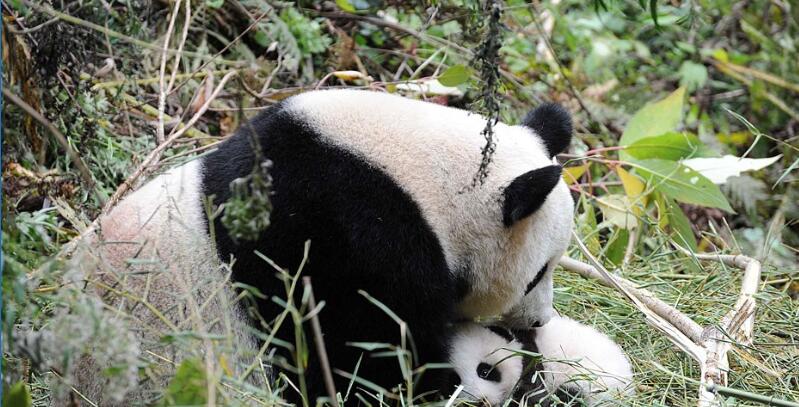Q: Why are giant pandas called “Mao Xiong”, the reverse of its popular Chinese name”Xiong Mao” in some places in China?
A: In 1869, French Catholic Father Armand David discovered giant pandas in Baoxing county Sichuan province. The following year the moniker “Black and White Bear” was officially renamed as a species,”Giant Panda”. The first version of the translation of “Giant Panda” is “Da Mao Xiong” with a shortened form of “Mao Xiong”. Historically Chinese would read scripts from right to left, and as a result pandas were gradually called “Xiong Mao” in Chinese.Presently only in Taiwan are pandas called “Mao Xiong” instead of its more popular Chinese name”Xiong NIao”. Hu Jinchu
Q:Does giant panda eat a lot? How large is an average panda’s appetite?
A: Approximately 99% of a giant panda’s diet is bamboo. They eat enormous amounts of it, approximately 40kg of bamboo shoots, 17-20kg of bamboo stems, or 10-14kg of bamboo leaves in a 24-hour period. They have rapid digestive processes, excreting the shoots as quickly as 5 bows after consumption.It takes 10 to 14 hours for the stems and leaves to be fully digested. Hu Jinchu
Q:Is giant panda fur waterproof? Does it have a lot of natural oils?
A: Giant pandas have thick and rough fur covering the entire body. Although it is not quite waterproof the fur prevents the water h:ore quickly seeping into the skin. Meanwhile, this thick and rough fur is also rich in natural oils, which protects the skin and whole body and acts as a thermal barrier, defending against cold and moisture.Wu Kongjyu
Our Experts
Hu Jinchu
Professor and director of Institution of Rare and Precious Animals and Plants, China West Normal University. He is also a world-renowned giant panda expert and has been enjoying the special allowance of the State Council since the year of 1991.
Wu Kongjyu
Senior livestock engineer and supervisor of Animal Management Department of the Chengdu Research Base of Giant Panda Breeding.
Focus: Nutrition,dietary monitoring,and breeding of giant pandas and red pandas.
Lan Jingchao
Senior veterinarian and vice director of the Animal Disease Prevention and Control Department of Chengdu Research Base of Giant Panda Breeding.
Q: Does the sub-adult giant panda live completely independently after leaving its mother? Will it live with its father?Does a male adult giant panda know exactly who his child is?
A: Giant pandas are solitary animals, which means that the sub-adult giant panda will live independently after leaving its mother. After breeding, male pandas return to their territories and have no role in cub rearing. They do not know their offspring and the sub-adults do not live with their fathers at any time. Wu Kongjyu
Q:When are panda cubs weaned?
A: Before more modem techniques were developed and when researchers were only interested in breeding for quantity giant panda cubs usually were weaned at six months of age. After that point they were fed with formula in order to guarantee that the panda mothers were able to breed in the following year. Unfortunately the practice of early weaning curbed cub’s behavioral development and contributed to highly diminished immunity in the cub population resulting from a shortened exposure time to antigens found only breast milk. Vast improvements have been made in the area of giant panda conservation and breeding, and now cubs at the Chengdu Research Base of Giant Panda Breeding are not weaned until two years of age, mimicking the actual situation in the wild. Lan Jingchao






















































































